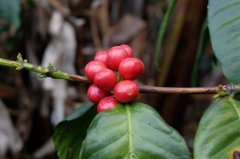How are coffee beans graded? are coffee beans graded by size?

Professional coffee knowledge exchange more coffee bean information please follow the coffee workshop (Wechat official account cafe_style)
In the coffee production process, there is a link is to grade coffee raw beans, divided into different grades of coffee raw beans, to facilitate export, quality control and raw bean price. The better the grade of raw coffee will be, the higher it will be. Each country has its own grading system. Because the national conditions are different, there is not a set of international grading system for raw coffee. Some are graded according to altitude and some according to the size of coffee, all of which are designed to select beans and sell them at a higher price with better quality.
Next, let's talk about the grading system of raw coffee beans in various countries.
Classification of coffee beans
Coffee beans are graded in different countries according to different grading systems. Some of these classification processes are overly complex and ineffective, such as the Haitian classification method, while the classification devices used in Brazil, despite their complex structure, are indeed necessary. Overall, there are six export levels, the highest being SHB (strictly hard bean)-extra hard coffee beans, or highland coffee beans, produced in highlands no less than 400m above sea level.
Generally speaking, the fruit of coffee is made up of two oval seeds opposite each other. The side that connects with each other is a flat joint, so it is called flat bean. But some are made up of a round seed, and its taste is no different.
(3) filter screen (size of coffee beans)
Species filter number coffee bean size
Pingdou 20mur19 extra-large 18 large 17 quasi-big 16 ordinary 15 medium 14 small 13 Mutual 12 extra-small
Dou 13 Rue 12 big 11 quasi-big 10 ordinary 9 medium 8 small
This classification is adopted in most countries, such as Brazil, Colombia, Tanzania and so on. Although there may not be an absolute relationship between the size and quality of coffee beans, it can at least make the size of raw coffee beans the same.
(4) classify by elevation
According to the elevation of the cultivated land, it can be divided into three, four, seven and so on, and the grade standards vary from country to country. For example, Mexico and Honduras use three levels, while Guatemala uses seven levels. Generally speaking, the quality of highland beans is better than that of lowland beans, and the price is higher because of the increase in freight.
Grade name elevation (m)
1 Premium beans 1500 2 Superior beans 1200mur1500 3 medium beans 1000mur1200 4 Superior Water washed beans 900Mel 1000 5 Superior Water washed beans 760Mel 900 6 Superior Water washed beans 610Mel 760
7 excellent water washed beans 610
(5) quality type
The type and quantity of blends (defective beans) contained in a certain amount of samples are converted into the number of defective beans, and their sum is used as the basis for determining the type of quality. Brazil, Ethiopia, Cuba, Peru and other countries all have benchmarks for the number of defects, and the smaller the value, the better.
Defective beans, including moth-eaten coffee beans, immature, fermented, shell beans, chopped beans, etc., can be inspected by their appearance.
Determine the degree of external defect according to the sundries in the bean. Coffee beans can be classified as NO.2-8 (the smaller the number, the higher the level)
Granulated flat beans: large grains-- 19 peas in 17 meshes-16, 15 meshes small grains-14 meshes mocha beans: large granules: 13 peas 12 Mel 11 meshes 10 meshes small grains: 9 below
Round beans: 10 murmur13 items
Coffee size classification
Coffee beans are graded first by size and then by density. With two exceptions, all coffee beans have a considerable size and the same proportion, with flat on one side and semi-oval on the other. The special cases are pea-shaped coffee beans that tend to be oval in shape and giant coffee beans with large grains (that is, Marragol peel coffee beans), both of which are always more expensive.
Generally speaking, the quality of large coffee beans is better. The size rating of coffee beans is usually expressed in terms of 10mur20, but in some countries coffee beans are graded according to levels corresponding to a certain size, such as AA. The way to determine the size of coffee beans is to pass them through a sieve. But even so, there may be weight differences between coffee beans of the same size, and bad, crumpled coffee beans must be removed.
The best way to separate unwanted coffee beans from good ones is to use gravity and air. The compressed air method is manual and requires higher technology, which uses jets to separate heavy and light coffee beans.
Another method is to use a weight separator to make heavy coffee beans fall by putting coffee beans on raised plates and letting air pass through them. This is also a technologically demanding method, if used properly, coffee beans can be separated more accurately and effectively.
Different varieties are grown in different countries, coupled with differences in geographical environment, even the final flavor of the same variety of coffee beans grown in different countries is different, which is no wonder why each country has its own coffee grading system, and it is not surprising that there is no international coffee grading system.
END
Important Notice :
前街咖啡 FrontStreet Coffee has moved to new addredd:
FrontStreet Coffee Address: 315,Donghua East Road,GuangZhou
Tel:020 38364473
- Prev

Hand filter cup choose which material is good to use | teach you how to use kono filter cup
Professional coffee knowledge exchange more coffee bean information Please pay attention to the coffee workshop (Wechat official account cafe_style) there are not many tools used for hand-brewing coffee, filter cups, hand pots, sharing pots, filter paper, electronic scales, thermometers and so on are indispensable, each of which may affect the flavor of coffee, if you do not make a good cup of coffee because of a certain link, making the customer's
- Next

The efficacy of coffee classification and taste characteristics _ common coffee varieties and price pictures
Professional coffee knowledge exchange more coffee bean information Please follow the coffee workshop (Wechat official account cafe_style) in this era of petty bourgeoisie sentiment and ritual life, coffee culture is increasingly coming into people's lives, unground coffee beans are also gradually known by the public. Both instant coffee and high-grade coffee beans are processed from the seeds of the fruits of coffee trees.
Related
- Beginners will see the "Coffee pull flower" guide!
- What is the difference between ice blog purified milk and ordinary milk coffee?
- Why is the Philippines the largest producer of crops in Liberia?
- For coffee extraction, should the fine powder be retained?
- How does extracted espresso fill pressed powder? How much strength does it take to press the powder?
- How to make jasmine cold extract coffee? Is the jasmine + latte good?
- Will this little toy really make the coffee taste better? How does Lily Drip affect coffee extraction?
- Will the action of slapping the filter cup also affect coffee extraction?
- What's the difference between powder-to-water ratio and powder-to-liquid ratio?
- What is the Ethiopian local species? What does it have to do with Heirloom native species?

